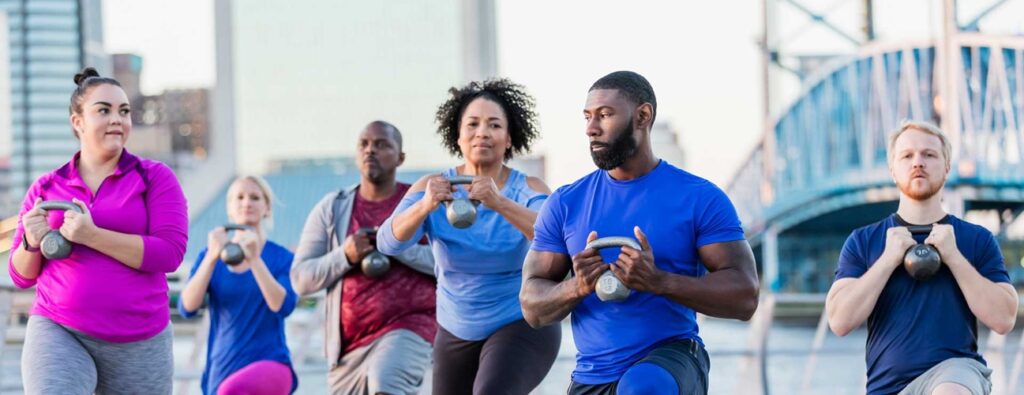Prepare Your Body for Exercise: Top 3 Strategies

Have you ever found yourself starting a session of physical activity and something felt off? Could you not perform at your highest level? You may need to learn how to properly prepare your body for exercise. Read further to find out all the things you can do to fix this issue and feel like your best self every time you get active. See some frequently asked questions at the end!
1. Prepare your body through fuel
To prepare your body for exercise, you have to start far before the physical activity itself. Eating to prepare for an oncoming day of exercise is consistent with eating well for a healthy lifestyle. A couple things to focus on with regards to your daily diet are:

- Lean proteins such as skinless chicken/turkey or fish
- Whole grains such as whole-grain bread, pasta, and brown rice
- Variety of fruits and veggies – Lots of colours!
- Avoid solid fats and added sugars such as margarine or processed sweet treats
- Drink lots of water!
While these guidelines are good to follow in your everyday life, nutrition should change slightly in the time frame leading up to long bouts of physical activity. Around 3-4 hours before exercise, properly preparing your body means having a balanced meal that is high in carbohydrates with some protein. Within 60 minutes of physical activity, and throughout the activity, have small carbohydrate rich snacks to maintain available body fuel. Water and fluid consumption is important to keep up throughout this entire time frame.
If you have any pain or inflammation concerns during exercise, click here to find out how your diet can help.
2. Prepare your muscles
Before you begin your activity, it is important to prepare your muscles for exercise by getting them moving through the correct movement patterns and by stretching. To fully prepare your body for exercise, start by slowly going through the exercise motions, taking the different muscle groups through their full ranges. Start general and work into the more specific movements. Take small breaks throughout to dynamically stretch any especially tight/sore muscles. Dynamic, meaning stretch the muscle while continuously moving. As your body starts to get used to the motion, slowly increase your speed/power, in small steps at a time.

For a full warm up example, imagine someone with tight calves trying to warm up for a long walk/run. To warm up the proper muscle groups, they should start by walking/running at a slow pace. They take breaks throughout their warmup, going into a calf/other stretches and rocking back and forth in the stretch to keep the muscles moving. As they start to feel more comfortable, they will slowly ramp up the speed in small increments.
For a different example, think about someone trying to prepare the body for a round of golf. First, they need to get the general body parts moving which could include arm and hip circles, or any other combination of movements. The golfer will then move into more specific motions, perhaps practicing slow upper body rotation in the same position as a golf swing. Eventually they will use a golf club and start some slow and controlled practice swings. Throughout the process they will take dynamic stretching breaks as they work up to full speed swings.
Contact us for help making a warm up program, specific to you and your goals!
3. Prepare your body with sleep
You may not realize that sleep has a huge impact on your ability to perform during physical activity. 1 in 3 people worldwide experience sleep related issues which can cause many physical problems that may get in the way of you staying active. The recommended amount of sleep for adults ages 18-64 is 7-9 hours which can increase the healing speed of your body, reduce inflammation, decrease your sensitivity to pain, and help prepare your body for exercise!
If you struggle getting enough sleep or getting good quality sleep, here are some things you can add into your daily routine.
- Be consistent. Go to bed and wake up at the same time every day of the week.
- Make sure your sleeping area is quiet and cool.
- Avoid electronics in the bedroom and before sleep.
- Avoid large meals, caffeine or alcohol within 2-3 hours of going to bed.
- Change your sleep position and/or pillow choice.
Changing your sleep position doesn’t only help with your quality of sleep, but may also reduce any stiffness or pain through your back that keeps you from being active. Adding a pillow under the knees for back sleepers, a pillow under the hips for stomach sleepers or a pillow between the knees for side sleepers will take pressure off of your low back and the surrounding areas while you sleep. This can decrease your daily aches and pains, allowing you to be better prepared to exercise. If fixing your sleep position isn’t causing any improvement, a custom pillow may be another option to consider.
FAQ
The biggest sign that you haven’t warmed up properly is being more sore than usual after exercising. Other signs are getting tired or losing your breath quicker than you’re used to. All of these signs serve as good indicators that you may not have warmed up properly, however, they do not guarantee that the problem was your warm-up as there could be other factors.
You can use the same general warm up for many different activities however there should still be some differences. It is okay to begin by using a similar movement and stretching routines but this should always be accompanied by further warm-ups that are more specific to what you are participating in.
There’s no such thing as too old, however, for anyone participating in physical activity, avoid activities that cause excessive levels of pain. If you have any concerns or are unsure, consult a care professional for personalized advice.

